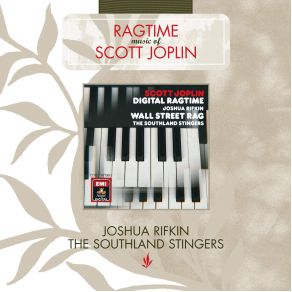Scott Joplin: Digital Ragtime / Wall Street Rag
Download links and information about Scott Joplin: Digital Ragtime / Wall Street Rag by Joshua Rifkin. This album was released in 1985 and it belongs to Jazz genres. It contains 15 tracks with total duration of 01:02:40 minutes.

|
|
|---|---|
| Artist: | Joshua Rifkin |
| Release date: | 1985 |
| Genre: | Jazz |
| Tracks: | 15 |
| Duration: | 01:02:40 |
| Buy it NOW at: | |
| Buy on iTunes $9.99 | |
Tracks
[Edit]| No. | Title | Length |
|---|---|---|
| 1. | Maple Leaf Rag | 3:07 |
| 2. | The Entertainer | 5:25 |
| 3. | The Easy Winners | 4:10 |
| 4. | Gladiolus Rag | 4:33 |
| 5. | Pine Apple Rag | 3:27 |
| 6. | Bethena (A Concert Waltz) (featuring The Southland Stingers) | 4:39 |
| 7. | The Favorite (featuring The Southland Stingers) | 3:05 |
| 8. | Stoptime Rag (featuring The Southland Stingers) | 2:58 |
| 9. | Heliotrope Bouquet | 5:55 |
| 10. | Paragon Rag | 3:51 |
| 11. | Solace (Mexican Serenade) | 7:06 |
| 12. | Magnetic Rag | 5:01 |
| 13. | A Breeze from Alabama (featuring The Southland Stingers) | 3:32 |
| 14. | Pleasant Moments (Ragtime Waltz) (featuring The Southland Stingers) | 2:45 |
| 15. | Wall Street Rag (featuring The Southland Stingers) | 3:06 |
Details
[Edit]Scott Joplin's surviving musical legacy, dating from the years 1895-1914 and including the opera Treemonisha, now appears mainly as a rosy cloud of old fashioned waltzes, marches, songs and two-steps, revolving around a nucleus of syncopated rags composed alone or in collaboration with similar-minded artists like Scott Hayden, Arthur Marshall and Louis Chauvin. Joplin's achievements contributed to the creation and development of jazz, and his famous "Maple Leaf Rag" of 1899 could itself be used as an index of that music's evolution, from Sidney Bechet through Earl Hines to Anthony Braxton and Muhal Richard Abrams. Joplin's compositions have been recorded by many fine pianists including William Albright, William Bolcolm, John Arpin, Richard Zimmerman and Max Morath. In December 1979, pianist Joshua Rifkin recorded a set of Joplin rags, revisiting a body of work he'd explored in three Joplin LPs which had appeared on Nonesuch in 1974. The plot thickened in 1985 when EMI combined nine of the 1979 piano solos with six chamber interpretations realized in January 1974 by the Southland Stingers, a California-based ensemble led by Angel Records producer George Sponhaltz and pianist Ralph Grierson. With academic and professional roots firmly anchored in the University of Southern California, the Southland Stingers patterned themselves closely after Gunther Schuller's New England Conservatory Ragtime Ensemble, with instrumentation consisting of violins, viola, cello and bass viol; flute, piccolo, clarinet, trumpets, trombone, tuba and drums — jazz lovers may want to know that the percussionist was Shelly Manne. Within the year 1985, EMI released this one album under three different guises: Scott Joplin: Rags & Waltzes; Ragtime: Music of Scott Joplin and, for the EMI Angel edition, Scott Joplin: Digital Ragtime/Wall Street Rag, with the word "digital" conspicuously added to indicate the use of the very latest in audio recording technology. (Excellent sound quality has since become commonplace, except of course in poorly condensed MP3 files, and is either taken for granted or in some cases narrowly insisted upon to the exclusion of any historic recording from the pre-LP era.) While the Southland Stingers toss off pleasantly invigorating arrangements of four rags and two waltzes, Rifkin generally obeys one of Joplin's cardinal rules by employing slower tempi so as to bring out the inherent beauty of "Heliotrope Bouquet," "Gladiolus Rag," the wistful masterpiece "Solace" and "The Entertainer," a fine piece usually subjected to hyper-caffeinated execution or the kind of careless abuse associated with motorized ice cream vendors. Rifkin takes "The Entertainer" at an uncommonly relaxed pace, and the results are incredibly rewarding. He does accelerate just a bit for the "Pine Apple" and "Paragon" rags, and the contrast between these and the reveries helps to achieve a healthy equilibrium in the mind and heart of the listener. The entrance and re-entrance of the Southland Stingers (tracks 6-8 and 13-15) make for even greater contrast as they present Joplin's music in a festive and lighthearted manner of which the composer would most likely have approved.